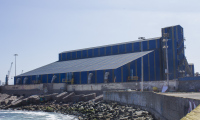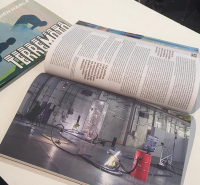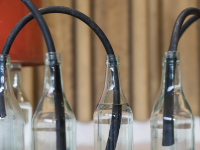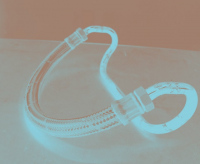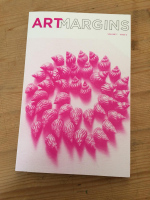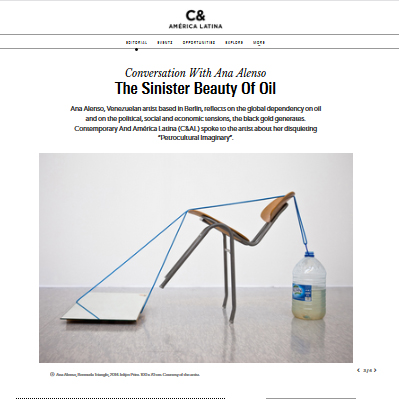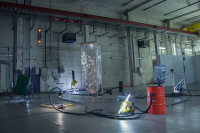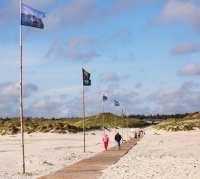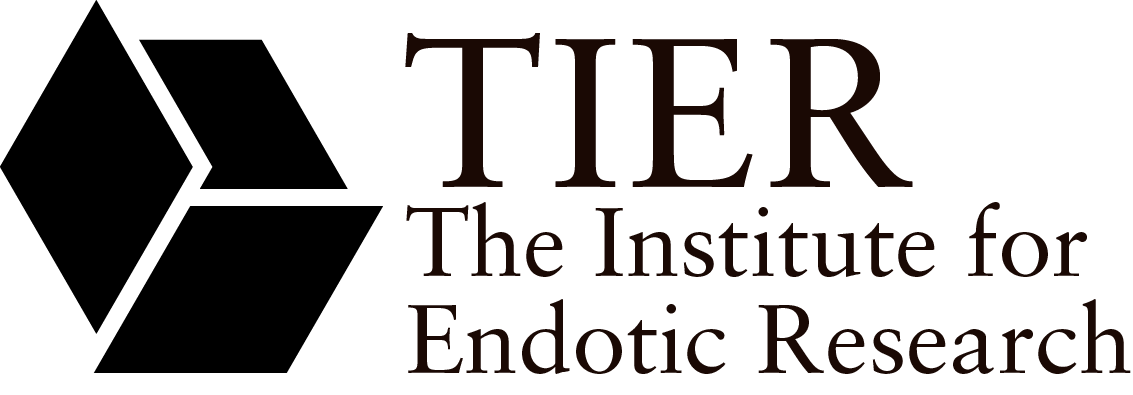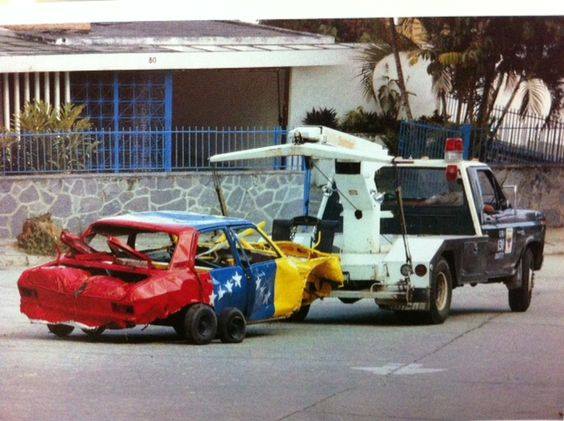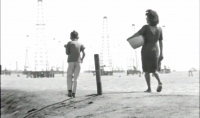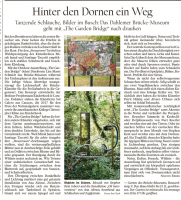
Review of The Garden Bridge at Brücke Museum Berlin.
Text: Simone Reber
Der Tagesspiegel. 15.08.2019
.
"Den Übergang zwischen Dunkelholz und Lichtung markiert eine gut getarnte Installation von Ana Alenso. Zwischen den Zweigen windet sich ein Benzinschlauch mit Tankrüssel in Spiralen, bäumt sich vor einem Spiegel auf und bleibt in der Luft hängen. Natur und Technik gehen ineinander über, bereichern sich, statt sich zu berauben".
Review of the videoinstallation: Desviar la inercia.
Text: Rodolfo Andaur.
Online Magazin RELIEVE CONTEMPORÁNEO
"Desviar la inercia” destaca de manera teórica, crítica e histórica a estos paisajes y lo que conllevan sus representaciones simbólicas frente a una incipiente lucha por efectivas políticas de sustentabilidad. El paisaje de la industria minera impone una noción compleja y una delimitación conceptual para la misión del arte actual que, ciertamente, debe ser enfocada, por lo general, entre un sentido crítico y bajo un eje histórico."
Link: relievecontemporaneo.com
Interview
April 22, 2019 — TERREMOTO MAGAZIN
Erik del Búfalo en conversación con Ana Alenso
Erik Del Búfalo speaks with artist Ana Alenso about the questions her work activates around the imaginaries of uncertainty within the Venezuelan present, perpetuated by a voracious petro-state.
Review of Extraction: Liquid Flames of the Solid Core
at Galerija Miroslav Kraljevic, Zagreb, Croacia
Texto: Jaume Amills y María Muñoz
Extraction y sus obras llenas de lucidez, nos adentra en un episodio habitual de la contemporaneidad y funciona como elemento que hace avanzar o retroceder en la historia. Tanto Alenso como Soto nos hablan de extracción y preservación, de ecologismo y biodiversidad, de los sistemas de producción, de las consecuencias del capitalismo y de la tierra como valor superior.
Link: Neo2
Sitting Circles
Galerie Wedding
13.06.2019 bis 10.08.2019
Eine Gruppenausstellung mit Ana Alenso, Ada Van Hoorebeke, Okka-Esther Hungerbühler, Cosima zu Knyphausen, kate-hers RHEE kuratiert von Marie-Christin Lender
Image: Alenso, »Vertical Waters«, 2019, skulpturale Installation, Detail, Maße variabel
Copyright: Galerie Wedding, 2019 & Ana Alenso
Article / Review Homeland's Agenda, 2016
ARTMargins and the Massachusetts Institute of Technology
A video installation in collaboration with Alessandro Balteo-Yazbeck
Text by Arnaud Gerspach.
"The work assumes the general equivalence of media—public government broadcasting, propaganda, diverse Internet corporate news channels, pop music lyrics, video testimonials of varying polish—so that each successive clip does not necessarily dominate the others. The result is a distillation of content, as form frequently coerces its own interpretation. The transcript provides a similar democratization of content, revealing a complex situation that would otherwise be impossible to experience for audiences not initiated in the local context"
Link: https://www.mitpressjournals.org/doi/pdfplus/10.1162/artm_a_00220
Interview
Mon 19 Nov, 2018 - Contemporary And América Latina (C&AL)
By Aristides Santana.
Ana Alenso, Venezuelan artist based in Berlin, reflects on the global dependency on oil and on the political, social and economic tensions that black gold generates. Contemporary And América Latina (C&AL) spoke to the artist about her disquieting “Petrocultural Imaginary”.
Interview
1.000.000% de Ana Alenso o la inflación perpetua
Publicado por traficovisual el 03/12/2018
Text: Augusto Geradi.
"Crecí con la idea de que somos un país rico en petróleo, con una naturaleza exuberante y mucha tierra fértil. Sin embargo creo que vivimos en una gran contradicción, justamente lo que en economía política describen como el fenómeno de “la paradoja de la abundancia o maldición de los recursos ”. Esta paradoja me ha obsesionado durante los últimos años y me ha llevado a desarrollar un “imaginario petro-cultural”, en donde la materialidad de los objetos es protagonista y en donde me aproximo a diferentes cuestiones poéticas, ecológicas y geopoliticas." A.A
Link: http://www.traficovisual.com/2018/12/03/1-000-000-de-ana-alenso-o-la-inflacion-perpetua/
New Adventures in Vexillology #5
Projekt Sommer 2019 kuratiert von Valeska Hageney und Imke Kannegießer
beteiligte Künstler Ana Alenso, Laura Bruce, Tue Greenfort, MoreUtopia!, Sophia Pompéry, Tita Salina
Ana Alenso kombiniert entfremdete aber dennoch identifizierbare Logos der Ölindustrie mit einem Fisch auf schwarzem Grund. Nicht nur Ölkatastrophen, sondern auch Offshore-Bauwerke wie etwa Ölförderungsplattformen, greifen massiv in die Ökosysteme der Meere ein. Der Begriff „Fair Use“, den Alenso hier für ihre Flagge gewählt hat, bezeichnet eigentlich die Rechtsdoktrin bestimmter Urheberrechts-Systeme und des so genannten Common Law. Es erlaubt die unlizenzierte Verwendung sonst urheberrechtlich geschützter Werke, wenn sie der öffentlichen Bildung und der Anregung geistiger Produktionen dient. Die Aneignung ökologischer Güter wie z. B. bei der Ölförderung sollte ebenso kritisch, reflektiert und der Allgemeinheit dienend, statt ausbeutend und rein wirtschaftlichen Interessen folgend, stattfinden.
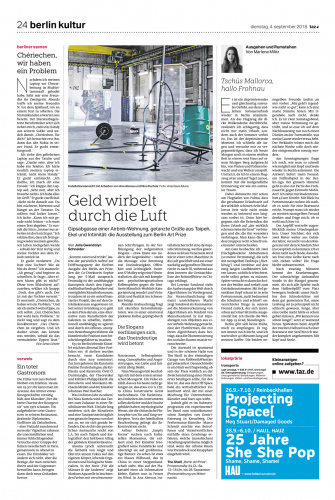

The Nominees
.
Related Press:
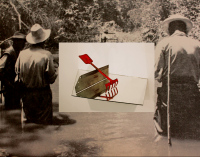
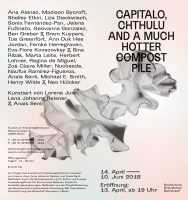
Ausstellungstext
The current moment is marked not by an ecological crisis, as a temporary state of emergency, but by an irreversible mutation of the global climate and planetary habitability of Earth. It is a process driven by environmental pollution, ocean acidification, resource extraction, the burning of fossil fuels, agrochemical industries, and warfare, to list but a few of the anthropogenic, human factors. The term Anthropocene is commonly used to describe this very condition, giving name to a new geological epoch, defined by the significant human impact on Earth's biospheric stability.
But this term is not undisputed. It places humanity as a major geological agent, rendering invisible the structural responsibility of neoliberal financial elites and corporations. The Capitalocene –the age of capital– in contrast, draws attention to global financial systems, highlighting the climatic impact of the capitalist political economy. Being aware of the biophysical costs of capitalism and its unequal distribution of human and ecological expenses, the current debate concerning how to think about humanity-in-nature and nature-in-humanity is a core theme of this exhibition.
Human and non-human actors are entangled in complex and tentacular networks, a myriad of ongoing connections extending across biotic and abiotic processes. The Chthulucene is the age of multi-species interactions and generative collaborations in a damaged world. Chthonic or earthly entities entwine with speculative fabulation, science fiction, science fact and speculative feminism to think of possible worlds and times in unexpected company. It is a rich terrain of muddled alignments that compose more livable stories beyond catastrophist and determinist discourses.
In an attempt to reject essentialist propositions and engage with postcolonial ecological thought, Capital, Chthulu, and a Much Hotter Compost Pile shows artistic positions that consider alternative ontological politics, reflect on environmental questions and speculate on possible narrations for our precarious times. These are stories of life (and non-life) told from the other side, to rethink how humans can fit, co-belong, co-produce, co-weave and com-post within this web of life.
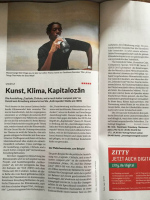
Review exhibition: Capitalo, Chthulu, and a Much Hotter Compost Pile
at Kunstraum Kreuzberg Bethanien
Mai 17. 2018 - Zitty Magazin.
Text: Raimar Stange
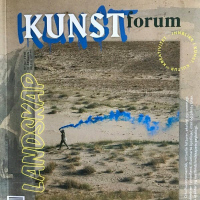
Kunstforum Review, 2018
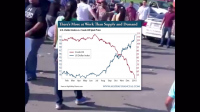
Tropical curse, 2015 @anaalenso
video screening for the public space
‘The One Who Teeters on The Brink Of Disaster’
curated by Eli Cortiñas, a Spanish video artist based in Berlin
In Homi K. Bhabha’s famous essay “The Commitment to Theory” culture emerges as a problem at the point at which there is a loss of meaning in the articulation of everyday’s life, between classes, genders, races, nations. The intervention of the Third Space of Enunciation as he describes it, destroys the mirror of representation in which cultural knowledge is customarily revealed as an integrated, open and expanding code. It is exactly in this space that video artist Eli Cortiñas situates the group of international artists presented in this program. An urgent search of extravagant and exuberant mysteries, an autonomous staging of possible violent scenarios, tropical economic values, stripteases of one’s own soul, lost of commodities and the fall of ideal projects of long gone futures go hand in hand to establish an unknown space, a new order between signifier and signified.
selected films:
Stine Marie Jacobsen Do you have time to kill me today?, 2007-2009, 2:50 min
Ana Alenso Tropical Curse, 2015, 3:33 min
Elodie Pong Je suis un bombe, 2006, 6:28 min
Glenda León Inversión, 2011, 3 min
Chrischa Venus Oswald Mother Tongue, 2013, 4 min
Agnieszka Polska Ask the Siren, 2017, 10:25 min
Pauline Curnier Jardin Grotta Profunda (the moody chasm), 2011, 30 min
Exhibition and seminar CARACAS RESET at La Colonie organized by Rolando J. Carmona and hosted by #KaderAttia
Showing my video Tropical Curse, 2015
http://www.lacolonie.paris/agenda/caracas-reset
Photo: La Chatarra, Juan Loyola, 1980
FILM SERIES how does the world breathe now?
Session N°34: Oil Files presented by Ana Alenso
September 6, 2017 | 7 PM SAVVY Contemporary | Plantagenstraße 31 | 13347 Berlin
For our 34th screening Ana Alenso presents Oil Files, a compilation of 7 video-art works of Venezuelan artists from 1968 to 2016. The selection focuses on the relationship between oil production and Venezuelan culture, especially as it relates to structural problems of social inequality and corruption, seeking to give the audience insight into Venezuela’s contemporary history and its current deep-scale crisis.
Pozo Muerto (1968) by Carlos Rebolledo.
BLACK GOLD FIRE (2015) by Rolando Peña.
Tropical curse (2015) by Ana Alenso.
Prototipo de vivienda en país petrolero (2004) by Alexander Apóstol
Panorama Miraflores (2014) by Iván Candeo.
The dogs keep barking (2016) by Erika Ordosgoitti.
Reconversión (2008) by Marco Montiel-Soto.
The event will conclude with an open discussion with the Venezuelan artists Ana Alenso and Marco Montiel-Soto, the Doctor in Latin American Studies Manuel Silva Ferrer, and writer Alberto Morreo.
LINK: http://savvy-contemporary.com/index.php/projects/filmseriespast/
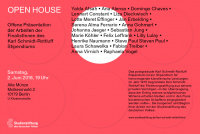
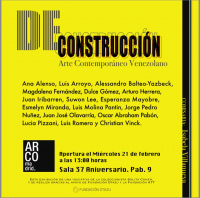

Money Laundering
Albano Afonso, Ana Alenso, Lehman Brothers,
Alejandro Gómez Arias, Kristian Touborg,
and Andrés Vial
Curated by Rodolfo Andaur
16 June - 8 July, 2017
Gothersgade 167, st.th. Wednesday-Friday 11-18, Saturday 13-17
------------------------------------------------------------------------------------------------------------------
Fit Frame to Content
ANA ALENSO, PATRICIA DOMÍNGUEZ, FERNANDA FIGUEIREDO, BARBARA MARCEL, AZAR PAJUHANDEH
Aug 12 - Finissage: Sep 1, 2017
Im Bereich Bildende Kunst werden im Jahr 2017 Recherchestipendien à 8.000 € an 52 in Berlin lebende und arbeitende bildende Künstler*innen und Künstler*innengruppen sowie an acht Kurator*innen und Kurator*innengruppen vergeben. Die Stipendien sind für die künstlerische bzw. kuratorische Weiterentwicklung im Bereich der bildenden Kunst bestimmt.
Der Jury für das Recherchestipendium Bildende Kunst gehörten in diesem Jahr an:
Stéphane Bauer, Boris Buden, Elodie Evers, Adrienne Goehler und Nanna Heidenreich.
Insgesamt wurden 575 Anträge gestellt, von denen die Jury folgende 52 Stipendiat*innen aus dem künstlerischen Bereich ausgewählt hat:
Al-Badri Nelles GbR, Ana Alenso, Ulf Aminde, Patrizia Bach, Mareike Bernien, Ana Bilankov, Tina Born, Thomas Bratzke, Nele Brönner, Andreas Bunte, Alyssa DeLuccia, Ruben Dhers, SuperFuture, Katja Eydel, Larissa Fassler, Azin Feizabadi, Constanze Fischbeck, Moritz Frei, Simone Gilges, Lisa Glauer, Lola Göller, Sarah Harrison, Naomi Hennig, Klara Hobza, Annette Hollywood, Birgit Hölmer, Kerstin Honeit, Imri Kahn, Joachim Lengerer, Angelika Levi, Bernd Lützeler, Wouter Osterholt, Andrea Pichl, VIP (Künstlerinnenkollektiv), Merchan Pol, Marcio Emanuel Rodrigues Carvalho, Andreas Rost, Susanne Sachsse, Katya Sander, Romana Schmalisch, Maximilian Schmoetzer, Henrik Schrat, Maya Schweizer, Miloš Trakilović, Sencer Vardarman, Ivar Veermäe, Rui Vilela, Julien Villaret, Michael John Whelan, Gernot Wieland, Ina Wudtke, Miriam Yammad.
Von den 575 Anträgen wurden folgende acht Stipendiat*innen aus dem kuratorischen Bereich ausgewählt:
Pauline Doutreluingne, Katia Hermann, Bettina Elisabeth Knaup, Jürgen Köhler, Tina Sauerländer, Mavra Berlin, Anna Voswinckel, Florian Wüst.
Kulturstaatssekretär Dr. Torsten Wöhlert dankt der Jury ganz herzlich für die Unterstützung und wünscht den Geförderten viel Erfolg in ihrer künstlerischen bzw. kuratorischen Arbeit.
http://www.berlin.de/sen/kulteu/aktuelles/pressemitteilungen/2017/pressemitteilung.608689.php
REVIEWS AND TEXT ARCHIVE
Exhibition review Ana Alenso: Tropical curse by Kenneth Heyes CMAGAZIN, CANADA
ARTE EMERGENTE EN VENEZUELA 2000/2012 by Felix Suazo, VE, 2015
-
Solo project en Swab, Entrevista por Carolina Ariza. 2014
-
"Trafico Visual" sobre Jovenes Con FIA, 2014
-
" El Nacional" sobre el Premio Eugenio Mendoza 2013
-
" El Universal" sobre el Premio Eugenio Mendoza 2013
-
" El Nacional" por Lorena González 2012
-
"Trafico Visual" , Conversa con Ana Alenso, Esto no es una clinica = Esto es un cuarto de
" El Nacional" por Carmen Victoria Mendéz. Ana Alenso hace poesía con las cosas que giran. 2012
